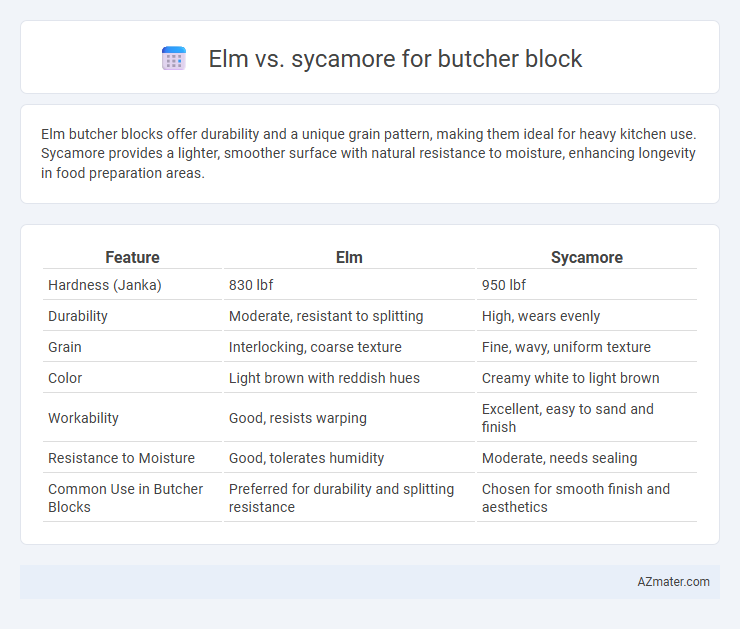Elm butcher blocks offer durability and a unique grain pattern, making them ideal for heavy kitchen use. Sycamore provides a lighter, smoother surface with natural resistance to moisture, enhancing longevity in food preparation areas.
Table of Comparison
| Feature | Elm | Sycamore |
|---|---|---|
| Hardness (Janka) | 830 lbf | 950 lbf |
| Durability | Moderate, resistant to splitting | High, wears evenly |
| Grain | Interlocking, coarse texture | Fine, wavy, uniform texture |
| Color | Light brown with reddish hues | Creamy white to light brown |
| Workability | Good, resists warping | Excellent, easy to sand and finish |
| Resistance to Moisture | Good, tolerates humidity | Moderate, needs sealing |
| Common Use in Butcher Blocks | Preferred for durability and splitting resistance | Chosen for smooth finish and aesthetics |
Introduction to Elm and Sycamore Butcher Blocks
Elm butcher blocks showcase a distinctive grain pattern and durability that makes them ideal for heavy kitchen use, resistant to dents and scratches while maintaining a warm, rich tone. Sycamore butcher blocks offer a lighter, creamy color and a tight, fine grain structure, providing a smooth surface favored for its aesthetic appeal and resistance to moisture. Both woods are hardwoods prized for their strength and longevity in kitchen environments, making them popular choices for functional and decorative butcher block surfaces.
Wood Hardness and Durability Comparison
Elm wood, with a Janka hardness rating of about 830 lbf, offers moderate durability and resistance to wear, making it suitable for butcher blocks that require some resilience but also flexibility. Sycamore, rated around 950 lbf on the Janka hardness scale, provides higher hardness and better resistance to dents and scratches, enhancing the longevity of butcher blocks under heavy use. Both woods resist moisture moderately, but Sycamore's greater hardness makes it the preferred choice for butcher blocks demanding superior durability and long-term performance.
Grain Patterns and Visual Appeal
Elm butcher blocks feature intricate, interlocking grain patterns with a coarse texture that offers a rustic and natural visual appeal. Sycamore butcher blocks present a fine, uniform grain with lighter color tones, lending a sleek and contemporary look to kitchen surfaces. Choosing between them depends on the desired aesthetic: elm enhances warmth and character, while sycamore promotes brightness and subtle elegance.
Workability and Ease of Crafting
Elm offers excellent workability with its interlocking grain, providing durability and resistance to splitting, making it ideal for butcher blocks that require frequent use. Sycamore's fine, even texture allows for smooth cutting surfaces and easy shaping, though it may require more care to prevent surface staining. Both woods craft well, but Elm's natural toughness makes it preferable for heavy-duty kitchen applications.
Maintenance and Longevity
Elm butcher blocks require regular oiling to prevent drying and cracking, benefiting from its natural resistance to moisture and insect damage. Sycamore butcher blocks offer a smoother, denser grain that enhances durability and resists knife marks better, needing less frequent maintenance. Both woods are long-lasting when properly cared for, but Sycamore typically outperforms Elm in longevity due to its tighter grain and hardness.
Resistance to Moisture and Staining
Elm butcher blocks offer moderate resistance to moisture and staining due to their interlocking grain structure, which helps prevent water absorption and surface damage. Sycamore butcher blocks exhibit lower resistance compared to Elm, as their fine, uniform grain tends to absorb moisture more readily, increasing the risk of stains and warping. Proper sealing and maintenance enhance the moisture resistance and stain protection of both Elm and Sycamore butcher blocks.
Sustainability and Environmental Impact
Elm butcher blocks are highly sustainable due to their fast growth rate and abundance in North America, making them an eco-friendly choice with lower carbon footprints. Sycamore wood, while durable and attractive, is less commonly harvested and grows slower, impacting its availability and environmental sustainability. Both woods are biodegradable and renewable, but elm's rapid regeneration and regional availability enhance its environmental benefits for sustainable butcher block production.
Cost and Availability
Elm butcher blocks tend to be more affordable due to the wood's wider availability and faster growth rate in North America, making it a cost-effective option for kitchen countertops. Sycamore, while less common, often comes at a higher price point because of its limited supply and slower growth, contributing to increased manufacturing costs. Availability of elm is widespread across furniture and lumber markets, whereas sycamore is less frequently stocked, potentially leading to longer wait times and higher shipping fees.
Best Use Cases for Each Wood
Elm is highly durable and resistant to splitting, making it ideal for butcher blocks frequently exposed to heavy chopping and moisture. Sycamore's fine, tight grain and attractive light color suit it well for butcher blocks intended for precise cutting tasks and aesthetic kitchen presentations. Both woods offer distinct advantages: Elm excels in toughness and longevity, while Sycamore provides a smoother surface and appealing appearance for lighter culinary uses.
Final Verdict: Choosing Between Elm and Sycamore
Elm offers a durable, moisture-resistant butcher block option with a distinctive grain pattern and natural shock-absorption, making it ideal for heavy kitchen use. Sycamore features a lighter, smoother texture with a fine, uniform grain that resists knife marks and provides a clean, modern look while maintaining good hardness and stability. For choosing between elm and sycamore butcher blocks, prioritize elm for rugged durability and rustic appeal, whereas sycamore suits those seeking a sleek, easy-to-maintain surface with consistent grain aesthetics.

Infographic: Elm vs Sycamore for Butcher Block
 azmater.com
azmater.com